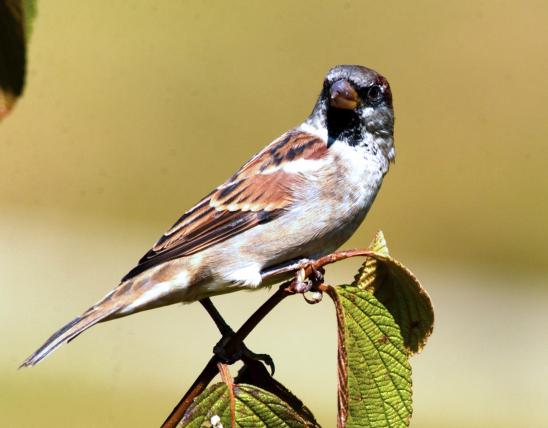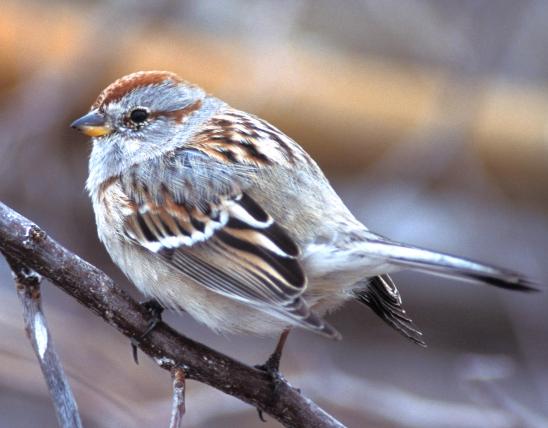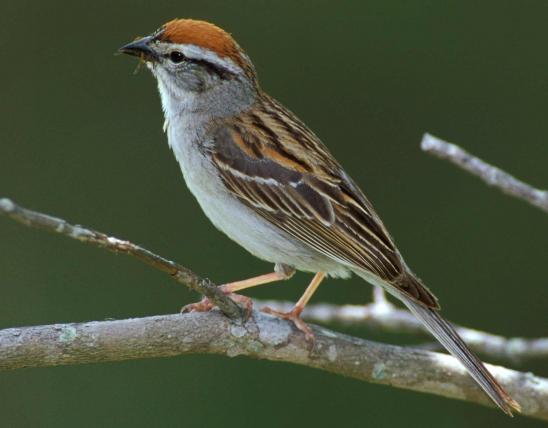
The Eurasian tree sparrow is similar to the house sparrow and may be missed when it appears in mixed flocks. Adult upperparts are reddish brown with a chocolate brown head. The eye line is black, and the cheek is white with a black spot in the center. Underparts are grayish, with a brownish wash on the sides and flanks. The black bib is much smaller than on the house sparrow. Song is higher pitched than the house sparrow's and is more metallic. Call is a hard tik tik given in flight, or a chit-chup.
Similar species:
- The house sparrow, its cousin that was also introduced to America, is grayer below and has a different color pattern on the head.
- The American tree sparrow, a native species, winters in Missouri and is similar in name. It has a reddish-brown crown and eyestripe; the eyebrow and cheek are gray; and there is usually a black spot in the center of the plain breast.
Length: 6 inches (tip of bill to tip of tail).

St. Louis vicinity only. Throughout all of North America, this introduced species is only present in the St. Louis area and in nearby areas in Illinois and southeastern Iowa.
Habitat and Conservation
Like its cousin the house sparrow, the Eurasian tree sparrow of the St. Louis area is not a true American sparrow; rather, both are Old World sparrows that are more closely related to species in Europe, Asia, and Africa. To the delight of nostalgic immigrants, the two species were introduced to America in the 1800s in hopes they would help control insect pests. Neither feeds much on insects, however, and the house sparrow, especially, has become a pest.
Food
Forages for seeds, grains, fruits, insects, and bread crumbs, on the ground or in trees.
Status
Nonnative. Common permanent resident (introduced). Range has been expanding from the St. Louis area, particularly northward. In the Old World, this species has a wide distribution across the continents of Europe and Asia, with several subspecies and races. The original 12 birds introduced in St. Louis in 1870 came from Germany. Their descendants number about 15,000 individuals today.
Life Cycle
Nests are built in tree cavities and are made of fine dried plant materials such as grass and straw, and lined with feathers, pieces of paper, cloth, and string, and other soft materials. A clutch comprises 4–7 eggs. They can live to be at least 4 years old.
Human Connections
These introduced birds were greeted first with joy, then with disappointment as they failed to gobble up insect pests. As they multiplied and feasted on grains, they became a frustration. Yet avid birders travel to St. Louis for a chance to add this species to their life lists (checklist of the bird species they've seen during their lifetime).
Ecosystem Connections
This species was introduced in St. Louis in 1870. Its population was doing well until house sparrows (introduced in New York in 1851) arrived in the area. The more aggressive, larger house sparrow settled in downtown St. Louis, and the Eurasian tree sparrow became more residential or rural.




About 350 species of birds are likely to be seen in Missouri, though nearly 400 have been recorded within our borders. Most people know a bird when they see one — it has feathers, wings, and a bill. Birds are warm-blooded, and most species can fly. Many migrate hundreds or thousands of miles. Birds lay hard-shelled eggs (often in a nest), and the parents care for the young. Many communicate with songs and calls.



























